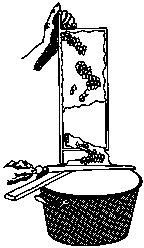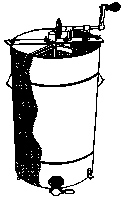How to Process Honey
Contents
Short Description
- Problem:Honey Processing
- Difficulty:medium
Many species of bees collect nectar which they convert in to honey and store as a food source. However, only bees which live together in large colonies store appreciable quantities of honey. These are bees of the genus Apis and some of the Meliponinae (stingless bees).
Bees prepare honey mainly from the nectar of flowers, but other plant saps and honeydew are also used. As each bee sucks the liquid up through its proboscis and into the honey sac, a small amount of enzymes are added and water is evaporated. The enzymes convert sugars in the nectar into different types of sugars - honeys always contain a wide range of sugars, varying according to the nectar source. After the liquid has been placed in the cell of honeycomb, bees continue to process it. The temperature of the hive is usually around 35°C and this temperature together with ventilation produced by fanning bees, causes further evaporation of water from the honey. When the water content is less than 20% the bees seal the cell with a wax capping: the honey is now considered 'ripe' and will not ferment.
Honey consists of a mixture of sugars, mostly glucose and fructose. In addition to water (usually 17-20%) it also contains very small amounts of other substances, including minerals, vitamins, proteins and amino acids. A very minor, but important component of most honey is pollen.
Processing
Honey should be processed as soon as possible after removal from the hive. Honey processing is a sticky operation, in which time and patience are required to achieve the best results. Careful protection against contamination by ants and flying insects is needed at all stages of processing.
It is important to remember that:
• Honey is a food and it must therefore be handled hygienically, and all equipment must be perfectly clean.
• Honey is hygroscopic and will absorb moisture, therefore all honey processing equipment must be perfectly dry. Too much water in honey causes it to ferment.
Honeycombs from top-bar hives or traditional hives
Cut-comb honey
Collect pieces of comb consisting only of sealed and undamaged honeycomb, cut them into neat portions and package them carefully for sale. Since the honey in the comb is untouched and is readily seen to be pure, honey presented in this way fetches a high price. Honey which has not been open to the air has a finer flavour than honey which has been subjected to processing in any way.
Strained honey
To prepare strained honey, remove the wax cappings of the honeycomb with a knife and break the combs into pieces, see Figure 1. Make sure that you do not use unsealed combs containing unripe honey or pollen. Use a cotton cloth to strain the honey from the pieces of honeycomb into a clean, dry container. Strained honey must not contain any trace of wax or other debris.
It is best to use a fairly course strainer at first, to remove large particles and then to use successively finer strainers. Finally squeeze the combs inside a cloth bag remove as much honey as possible. Form the wax into a block by melting it gently in a water bath or solar wax extractor.
Honeycombs from frame hives
Cut-comb honey
To produce cut-comb honey from frame hives it is necessary to use a wax foundation which does not contain strengthening wires and is thinner than that normally used in wired frames. Portions of cut-comb can be prepared for sale as described above.
Strained honey
Remove the wax cappings from the honeycombs with a long sharp knife which has been standing in warm water. Hold one end of the top-bar of the frame and rest the other end of the top-bar on a piece of wood placed across a dish, see Figure 1. Start cutting at the bottom of the frame and cut off the thin layer of wax capping and allow it to fall into the dish below the frame. Turn the frame around and cut off the capping on the other side and then place the frame in an extractor, Figure 2.
Some honey will stick to the wax cappings; do not waste this, but strain it out of the dish. Honey drains very slowly from cappings and may take over 24 hours.
Containers for marketing honey must be lightweight, low cost, and preferably transparent so that customers can see the product. Glass or plastic containers are usually used but in many countries these are difficult to obtain. Plastic sachets are cheaper alternatives.
In addition to attracting customers the label you put on your honey should give the following information:
• contents: Pure Honey
• source of the honey (eg sunflower, mixed blossom, tree honey etc)
• the country and district it was produced in
• your name and address
• the weight of honey in the container.
You may wish to add other information for the customer. For example, if you are packing comb honey, you could remind the purchaser that the whole comb including the wax is completely edible, or if you are selling strained honey, you may wish to provide an explanation of granulation.
Glucose is a major constituent of honey and when it crystallises (ie turns from a liquid to a solid), the honey becomes solid (granulated). Some honeys are much more prone to granulation than others but almost all honey will granulate if its temperature falls below 24°C. Granulation is a natural process and there is no difference in nutritional value between solid and liquid honey. If honey is required in the granulated form, but it is slow to granulate, the addition of 20% finely granulated honey will cause it to granulate if kept at a low temperature.
If a jar of granulated honey is required in the liquid form, stand it in warm water (60°C).
The aroma and taste of honey are its most important features, but honey is often judged according to its colour. The colour of honey depends mainly upon the source of the nectar. Usually dark-coloured honeys have a strong flavour while pale honeys have a more delicate flavour. Generally light coloured honeys are more highly valued than dark. Colour can sometimes be an indicator of quality because honey becomes darker during storage and heating.
Water content
If the water content of honey is greater than 19% the honey is likely to ferment. A low water content is therefore essential. Water content can be measured using a refractometer. In areas with a very high humidity it can be difficult to produce honey of sufficiently low water content.
HMF
HMF (Hydroxymethylfurfural) is a break-down product of fructose (one of the main sugars in honey) formed slowly during storage but very quickly when honey is heated. The amount of HMF present in honey is therefore used as a guide to the amount of heating which has taken place. Some countries set an HMF limit for imported honey. HMF is measured by laboratory tests and technical advice should be sought if export is being considered.
Some honeys have a very high pollen content which makes them appear cloudy and this is considered to be low quality. The presence of any other contaminations (eg particles of wax, bees, splinters of wood, dust) make the honey of very low value.
Books about beekeeping
• The Golden Insect: A handbook on Beekeeping by Stephen Adjare, ITDG Publishing
• Beekeeping in the Tropics: Agrodok 32, Agromisa
• Tools for Agriculture: A guide to Appropriate Equipment for Smallholder Farmers ITDG Publishing
• Directory of suppliers of beekeeping equipment world-wide, International Bee Research Association, 1982
• Beekeeping in Africa, FAO Agricultural Services Bulletin 68/6, Food and Agriculture Organization of the United Nations, Rome, 1990, http://www.fao.org/docrep/t0104e/T0104E00.htm
Useful contacts
Practical Action
The Schumacher Centre for Technology & Development, Bourton on Dunsmore, RUGBY, CV23 9QZ, United Kingdom.
Tel.: +44 (0) 1926 634400, Fax: +44 (0) 1926 634401
e-mail:practicalaction@practicalaction.org.uk web:www.practicalaction.org

International Bee Research Association
18 North Road, Cardiff, CF10 3DT, United Kingdom
Tel: +44 (0)29 2037 3409
Fax: +44 (0)29 2066 5522
E-mail: mail@ibra.org.uk
Website: http://www.ibra.org.uk/
The International Bee Research Association are a not-for-profit organization that was established in 1949, with a worldwide membership. IBRA aims to increase awareness of the vital role of bees in the environment and encourages the use of bees as wealth creators.
IBRA has also published a full list that includes over 265 suppliers, listed under their countries (a total of 40), and with an index to suppliers of specialised equipment.
Bees for Development
Troy
Monmouth
NP5 4AB
United Kingdom
Tel: +44 (0) 16007 13648
Fax: +44 (0) 16007 16167
E-mail: info@beesfordevelopment.org
Website: http://www.beesfordevelopment.org
Bees for Development produce a quarterly magazine, Beekeeping & Development, and produce books that are available through mail order.
Apimondia
Corso Vittorio Emanuele II, 101
I-00186 Rome - Italy
Tel: +39-6-6852286
Fax: +39-6-6852286 or 68308578
E-mail: APIMONDIA@MCLINK.IT
Website: http://web.inter.nl.net/hcc/beenet/apimintr.htm
Apimondia is an international organization including 55 national beekeeping associations representing all continents. Members include institutes studying beekeeping as well as institutions and firms promoting and trading products and equipment
Equipment suppliers
Please note this is a selective list of suppliers and does not imply endorsement by Practical Action.
Bellingham + Stanley Ltd.
Longfield Road, North Farm Industrial Estate
Tunbridge Wells, Kent TN2 3EY
United Kingdom
Tel: +44 1892 500400
Fax: +44 1892 543115
E-mail: sales@bs-ltd.com
Website: http://www.bs-ltd.com/
Refractometers
Swienty A S
Hortoftvej 16,
DK 6400 Sonderborg
Denmark
Tel: +45 74 48 69 69
Fax: +45 74 48 80 01
E-mail: swienty@aof.dk
Supply machines for filling jars, strainers & cutters to keep the honeycomb square.
The Bee Keeper's Supermarket
38 Milner Road
Maitland
Cape Town 7450
South Africa
Tel: +27 21 511 4567
Fax: +27 21 511 9962
All processing equipment, such as hives, clothing, honey pumps, bottling machines etc.
Thomas Apiculture
86 rue Abbé Thomas
Fay aux Loges, F-45450
France
Tel: +33 (0)2.38.46.88.00
Fax: +33 (0)2.38.59.28.28
E-mail: thomapi@wanadoo.fr
Website: http://www.thomas-apiculture.com
Steele & Brodie Limited Beehive Works
Kilmany Road, Wormit
Newport-on-Tay
Fife, DD6 8PG
United Kingdom
Tel: +44 (0) 1382 541728
Fax: +44 (0) 1382 543022
E-mail: steele&brodie@taynet.co.uk
Full range of beekeeping, queen rearing and honey processing equipment.
Korea Beekeeping Association and Korea Bee Product's Research institute
6F The Farmer's Hall
436-3 Hwaseo-dong, Jangan-gu
Suwon, 440-150
South Korea
Tel: +82 331 291 6622/1223
Fax: +82 331 291 6682
Website: http://www.korapis.or.kr
E-mail: apiary@chollian.net
References and further reading
This Howtopedia entry was derived from the Practical Action Technical Brief Honey Processing - Technical Brief .
To look at the original document follow this link: http://www.practicalaction.org/?id=technical_briefs_food_processing

